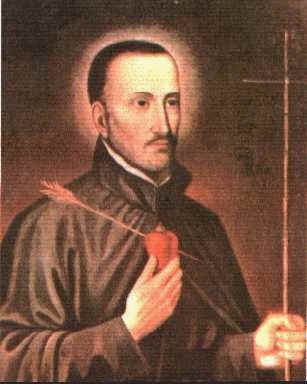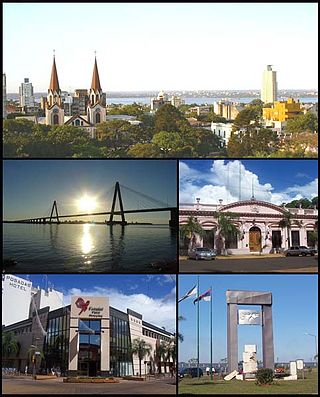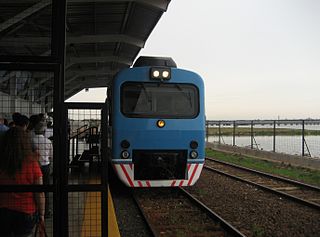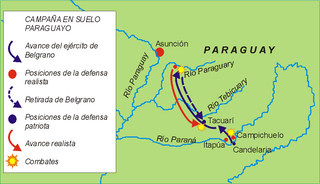
Misiones is one of the 23 provinces of Argentina, located in the northeastern corner of the country in the Mesopotamia region. It is surrounded by Paraguay to the northwest, Brazil to the north, east and south, and Corrientes Province of Argentina to the southwest.

Itapúa is a department in the southern region of Paraguay. The capital is the city of Encarnación. It is divided into 30 districts, more than any other district in the country.

Misiones is a department located in the southern region of Paraguay. Its capital is San Juan Bautista. The eighth of Paraguay's 17 departments, it was created in 1906, then known as the San Ignacio Department, and was not given its present name until 1945. Its current name reflects its status as home to several Jesuit Reductions, or missions.
Candelaria or Candelária may refer to:

Roque González de Santa Cruz, SJ was a Jesuit priest who was the first missionary among the Guarani people in Paraguay. He is honored as a martyr and saint by the Catholic Church.

Posadas is the capital city of the Argentine province of Misiones, in its south, at the far north-west of the country on the left bank of the Paraná River, opposite Encarnación, Paraguay. The city has an area of 965 square kilometres (373 sq mi) and a population of 324,756, and the Greater Posadas area has a population of over 359,609 according to a 2017 estimate.

Ayolas is a city in the department of Misiones, Paraguay, located at 310 km southeast of Asunción, on the banks of the Paraná River. It is, also, the name of the district within which the city is located.

Club Atlético Candelaria are a lower league football club from the city of Candelaria in the province of Misiones in Argentina.

Reducción de Nuestra Señora de Santa Ana was one of the many colonial missions for Indian Reductions founded in the 17th century by the Jesuits in South America during the Spanish colonial period.

Reducción de Nuestra Señora de Loreto, founded in 1610, was the first reductions established by the Jesuits in the Province of Paraguay in the Americas during the Spanish colonial period. The site is located in the Candelaria Department of Misiones Province, Argentina.

The General Urquiza Railway (FCGU), named after the Argentine general and politician Justo José de Urquiza, is a standard gauge railway of Argentina which runs approximately northwards from Buenos Aires to Posadas, with several branches in between. It was also one of the six state-owned Argentine railway companies formed after President Juan Perón's nationalisation of the railway network in 1948. The six companies were managed by Ferrocarriles Argentinos which was later broken up during the process of railway privatisation beginning in 1991 during Carlos Menem's presidency.

The Misiones Orientales (or Siete Pueblos de las Misiones (Spanish pronunciation:[miˈsjonesoɾjenˈtales], Sete Povos das Missões was a region in South America where a group of seven indigenous villages were founded by Spanish Jesuits in present-day Rio Grande do Sul, the southernmost State of Brazil.
Lampreado, also known as Lambreado or “Payaguá Mascada”, is a dish typical of the cuisine of Paraguay, that has a high nutritional value.

The National University of Misiones is a public university in Argentina. It has a publishing house and a radio station, LRH301 FM Universidad Nacional de Misiones, that streams in Ogg Vorbis format.

The Battle of Campichuelo was an action fought on 19 December 1810 between revolutionary forces led by Manuel Belgrano and royalist troops on the right bank of the Paraná River, part of the Paraguay campaign of the Argentine War of Independence. It ended with a victory for the forces of Belgrano.

The history of yerba mate stretches back to pre-Columbian Paraguay. It is marked by a rapid expansion in harvest and consumption in the Spanish South American colonies but also by its difficult domestication process that began in the mid 17th century and again later when production was industrialized around 1900.

The Argentina–Paraguay border is the line that limits the territories of Argentina and Paraguay. This boundary is solely defined by three major rivers: the Pilcomayo, Paraná and Paraguay, being one of the largest natural borders in the world. The capital of Paraguay, Asunción, lies on one of the banks of the Paraguay River, which borders Argentina. The capital of Argentina is Buenos Aires, which lies on one of the banks of the River Plate, made by major Paraguayan tributaries. Argentina is the country which Paraguay has the largest border with, being about 1,689 km long. It is Argentina's second largest border, after the Argentina–Chile border.
Candelaria is a department of the province of Misiones (Argentina). It contains the cities, towns, and villages of Bonpland, Candelaria, Cerro Corá, Loreto, Mártires, Profundidad, and Santa Ana. It borders the departments of San Ignacio to the east and northeast, Oberá to the far east, Leandro N. Alem to the south and southeast, Capital to the west and southwest, and the Republic of Paraguay to the north, separated by the Paraná River.
Capital Department is located in the southwestern tip of the Province of Misiones, Argentina.

Oberá is one of the 17 departments in the province of Misiones, Argentina. Located in the southeast, it borders the San Ignacio department, the Cainguás department, the Veinticinco de Mayo department, the San Javier department, the Leandro N. Alem department, the Candelaria department, and the Federative Republic of Brazil, separated by the Uruguay River. The department covers 1,564 km², which is 5.2% of the total province area.


















